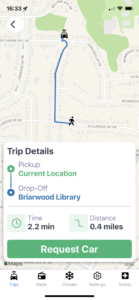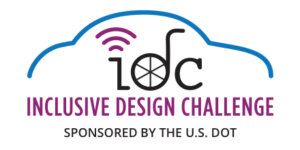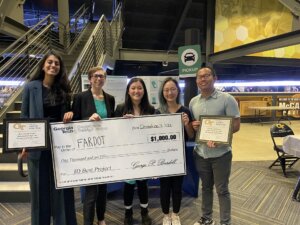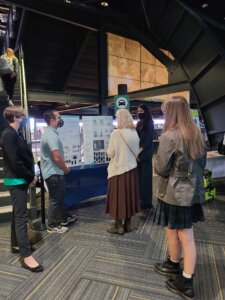Team FAR Challenge Timeline
Timeline

Progress at U.S. Airports
Submission, live demo, new podcast, and interview. Busy, busy, busy
Submission
It’s been extremely busy in April, May, and June putting the final touches on our Inclusive Design Challenge submission. In early May, we submitted our write-up and demo video. A lot of work went into making sure we answered all the questions posed in the write-up guidelines, and we had a great time filming our demo. During the Inclusive Design Challenge, we created a full, working prototype that covered all our proposed technology. We also created a working Autonomous Vehicle simulator to truly demonstrate that we had a fully operational system and app versus just an app that moved from page to page.
Live Demo
After our submission, we prepared for our live demo. We had additional technology we wanted to add to our system before we presented live to a large group of people. We added some great features, and with a week left before our live demo, we decided it was time to put a new face on our FAVI app. We designed our app to be fully functional with the interface being easily changeable to meet the needs of any market or group of users. Our design efforts were confirmed as we were able to get a completely new look on our app in just a few days.
Now we are awaiting the results of the challenge.
Podcast
Since our live demo, we are still working and living by our motto of “Always Forward”. Last week Chris spent an hour as the main guest on an accessibility podcast by Accessible Avenue (accessibleavenue.net) answering all kinds of questions about Autonomous Vehicle accessibility and questions about the Inclusive design challenge. It was a great time with some great questions and really showed the huge interest from the visually impaired community in AV. We’ll post a link when it’s available.
Interview
Tomorrow Chris will be interviewed by the Vanderbilt University School of Engineering Newsletter about the Inclusive Design Challenge, and what we are doing to make AV accessible.
More to come
We look forward to the coming age of Autonomous Vehicles and especially how they are going to be life changing for those with disabilities. More to come…
Busy Week
This is a very busy week at FAR. A combination of creating our write-up for our Inclusive Design Challenge deadline of May 1st is well underway, and at the same time we are working on videos demonstrating the incredible technology we have created over the past year or so. The question is how does one go about demonstrating a technology that in production will interface with an Automated Vehicle when you do not have an AV to test on? The answer is simple but a lot of work. You create an AV Simulator! If all goes as planned, our AV simulator will take commands from our FAVI system and simulate a drive (with a real driver following the simulator commands). The simulator will take commands from the User’s FAVI app and respond appropriately. The goal will be to demonstrate requesting your vehicle, successfully locating the vehicle, driving the route to the drop-off point, and then successfully finding the entrance to the destination location. It’s one thing to talk about what a technology can do, but the truth is that it’s always more helpful to see it in action. It’s a lot of work to put a good demonstration together, but we are hopeful we’ll get there and really show the value of what we have created.
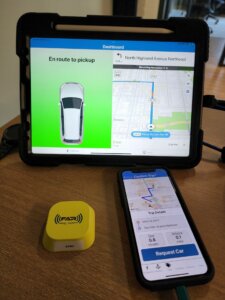
Automated Vehicle Simulator
This week also began the deployment of our bluetooth technology at the Minster School in Nottinghamshire, UK. We are very excited to bring greater independence to their visually impaired students.
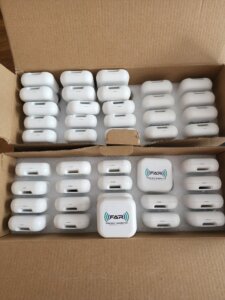
FAR Indoor Beacons
Finally, this week we also began the deployment of beacons on the bus system in Pensacola, Florida. These beacons will ride on each of their buses as well as being mounted on their bus stops. This deployment will help the visually impaired and those that have difficulties navigating more easily locate their bus stops and give them the ability to always know where their bus is on their route even if they miss the announcements. We see a future of switching from bluetooth to UWB beacons for our transportation systems to give even more accuracy and independence to our users.
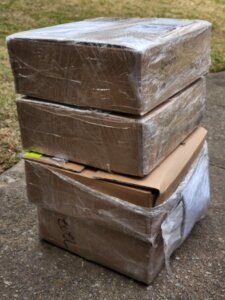
FAR Bus Stop Beacons
We love busy weeks and making an impact to improve the lives of people. We look forward to continuing to develop and create before our final Inclusive Design Challenge presentations in June.
Assistive Technology Update Podcast
Chris Webb, Foresight Augmented Reality’s CEO, and Tanner Gers, Director of Business Development, sat down with Josh Anderson, host of the Assistive Technology Update podcast to talk autonomous vehicles and the Inclusive Design Challenge.
Chris and Tanner co-authored the original proposal to the Department of Transportation for the Inclusive Design Challenge in 2020 and shared with Josh how you can use technology to guide a totally blind person without human intervention to use an autonomous vehicle.
What’s the biggest hurdle for autonomous vehicle accessibility?
The biggest difficulty for people with sensory and cognitive disabilities is safely and independently guiding users across what we call the first and last legs of the trip. From summoning a vehicle and finding it upon pickup, the first leg, and guiding the individual from the vehicle to the door of their final destination, the last leg, all without human intervention.
Check out the whole episode right here!
https://traffic.libsyn.com/secure/atupdate/ATU012122.mp3
You can also catch the episode on iTunes: Podcast
Or search for it on Spotify, Amazon Music and other podcasting services.
Autonomous Shuttles Event
FAR Flies North to Autonomous Shuttles Event in Ann Arbor
It’s cold outside, but February’s been hot for FAR!
This post shares a couple highlights since returning from a 4-way collaboration autonomous vehicle event in Ann Arbor Michigan, led by FAR’s strategic partner !Important and DOT Inclusive Design Challenge competitor May Mobility.
When Hannah Osborn, CEO of !Important, picked me up from my hotel in her !Important demo van, I was elated to say the least. Reason being, FAR and !Important are working hard behind the scenes to continue technical integration ahead of all FAR users being protected by !Important’s digital seat belt and FAR’s patent pending ultra-wide band system on !Important’s demo van. We’re certainly stronger and safer together.
The A2Go event was hosted in the garage in Ann Arbor where May Mobility parks their autonomous vehicles overnight. It was fascinating to see May Mobility’s working product in association with their proposal for DOT’s Inclusive Design Challenge.
May Mobility has 4 Lexus RX450h and 1 modified Polaris Gem that is wheelchair accessible operating in the Ann Arbor area. One person can ride in the wheelchair accessible Polaris Gem but the ramp into the vehicle requires a person to manually open and close it after the rider boards the vehicle. This is executed by staffed personnel funded by a grant secured by May Mobility.
The event was outstanding, and so were the speakers, but the conversations before, after, and during with friends and colleagues holds some of the most meaning and value for FAR. Like long-time friend John Shutko at Ford, Victoria Waters at Mcity, and Dan Bartz at Volkswagen.
Being a car person, one moment that made my hair stand was checking out Dan’s Audi A4 e-tron with level 3 autonomy, with LiDAR to prove it! Dan mentioned it only had 500 horsepower and was the slower version… Tease!
While not the exact same version, you can check out Audi’s A4 e-tron here. Thanks so much Dan for showing us your Audi A4 e-tron! My heart was pumping.
So much appreciation for !Important, May Mobility, Mcity, and Prentice 4M for attracting such an awesome crowd of professionals in the AV space. Can’t wait until the next one.
Speaking Out for the Blind Podcast
Chris Webb, CEO and lead engineer, and Tanner Gers, Director of Business Development, joined host of the Speaking Out for the Blind podcast, Brian McCallen, to discuss the #InclusiveDesignChallenge, smart city accessibility, and how we’re ensuring autonomous vehicles are accessible and usable by people with disabilities.
Listen to our episode on the Speaking Out for the Blind podcast by clicking here.
In case you missed it…
The US Department of Transportation just released the presentations of each Inclusive Design Challenge semi-finalist
On Monday January 24 and 26, each semi-finalist showcased the advancements made on their original proposed Inclusive Design Challenge prototype to ensure autonomous vehicles are accessible, usable, and enable people with disabilities to independently access vocational, educational, medical, and other critical destinations.
Semi-finalists showcased a wide range of solutions including numerous AV provider agnostic apps, AI aided navigation, automated wheelchair tie-downs, ultra-wide band, Bluetooth , and GPS capabilities. Solutions ranged across sensory, mobility, and cognitive disability types.
Foresight Augmented Reality’s Autonomous Vehicle Accessibility Solution
We were the third semi-finalist to present on Day 2 of the Inclusive Design Challenge Charrette. Due to the presentation’s 10- minute time limit, our strategy was to focus on the competitive advantages and unique capabilities to separate our solution from the rest of the semi-finalists.
In our presentation, we introduced FAR’s business to the audience, provided a brief overview of the presentation, and then a video demonstration of two totally blind travelers finding a simulated autonomous vehicle without human intervention.
Even more amazing is that both travelers were not provided any context about their relationship to the AV. This includes their distance, direction, or any instruction except being told they needed to use the app to find the simulated autonomous vehicle independently.
Here’s what FAR showcased during our Inclusive Design Charrette presentation:
- A functional prototype evidenced by a demonstration video that simulated the experience with both audio and visual accessibility features.
- Multiple commercial applications applicable to indoor, outdoor, public transit, ride-share, and autonomous vehicles.
- Incorporating technology partners !Important and what3words to provide users even more safety and capability
- How our solution supports sensory and cognitive disabilities with audio, text, haptic, and visual accessibility features
Day 1 Inclusive Design Challenge Charrette semi-finalists included:
- AbleLink Smart Living Technologies
- Carnegie Mellon University
- May Mobility & UMTRI
- University of Kansas
- University of Maine
You can see the day 1 presentations by clicking here and using passcode N02C
Day 2 presentation semi-finalists included:
- Boston University
- Clemson University
- Foresight Augmented Reality
- Purdue University
- Waymo
- And you can see the day 2 presentations by clicking here using passcode 5v@eXiu9
What are your accessibility goals?
To discuss how you can ensure people with disabilities can use and access your business, signage, or transit system, reach out to Tanner.
And subscribe to the blog if you want updates on new developments, capabilities, announcements, and the results of the Inclusive Design Challenge with a $2 million purse up for grabs!
Watch Live – DOT Inclusive Design Challenge Team Updates
FAR is neck deep in Phase II of the Inclusive Design Challenge!
Next week, January 26 at 3PM Eastern, FAR will be presenting our phase II updates to the Department of Transportation and Inclusive Design Challenge team alongside other semi-finalists.
FAR’s 10-minute presentation on Day 2 will be led by Tanner Gers, Foresight Augmented Reality’s Director of Business Development, where he will walk through FAR’s exciting developments, how FAR’s autonomous vehicle accessibility solution works, and share a video of a totally blind person using it to find a vehicle!
Join us live to learn more. Five teams will present in each session; advanced registration is required.
Day 1 (register)
Monday, January 24, 2022
11:30AM to 1:00PM Eastern
FAR’s presentation is here on Day 2 (register)
Wednesday, January 26, 2022
1:30PM to 3:00PM Eastern
Team FAR on Atlanta’s WSB TV News
We were excited to be interviewed by Fred Blankenship of Atlanta’s ABC affiliate WSB TV News about our new technology being developed for the visually impaired in the DOT Inclusive Design Challenge. We spoke about how our company came about through David’s experience getting hit by a vehicle, how our technology will be indispensable for the visually impaired when taking Autonomous Vehicles, and how the DOT Inclusive Design Challenge is helping this technology to happen. Not everything we spoke about aired, but the story ran on the 4pm, 5:30pm, and 6pm news. The 5:30p and 6pm news anchors spoke about the DOT Inclusive Design Challenge, but the 4pm news did not mention it, and that is the one they posted on their website with the Inclusive Design Challenge being mentioned in the text. It was an exciting day! You can read and watch it below:
Congratulations to the GT Students!
Congratulations!!!!!
As mentioned previously, one of the takeaways from our focus groups with the visually impaired was the need for standardized, accessible pickup/drop-off points for Automated Vehicles. The DOT Inclusive Design Challenge semi-finalist position has allowed us to explore that by sponsoring a group of Industrial Design/Mechanical Engineering seniors at Georgia Institute of Technology (Georgia Tech). These students have done a spectacular job, and yesterday at the CAPSTONE presentation they took FIRST PLACE in the Industrial Design category. We are incredibly proud of these amazing students, and they have taken our technology and envisioned new and standardized ways it can be used to help those with disabilities when using Automated Vehicles. More details will be coming as they finalize their report. To learn more: GT FARDOT Project
